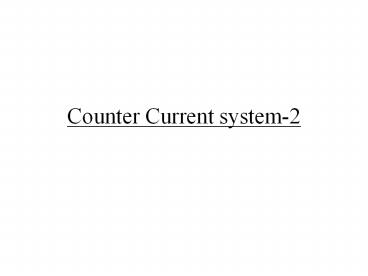Counter Current system-2 PowerPoint PPT Presentation
1 / 32
Title: Counter Current system-2
1
Counter Current system-2
2
- Before the vertical osmotic gradient is
established, the medullary interstitial fluid
concentration is uniformly 300 m Osm/L as in the
remainder of the body fluids
3
(No Transcript)
4
(No Transcript)
5
Step- 1
- The active salt pump in the thick ascending limb
is able to transport NaCl out of the lumen until
the surrounding interstitial fluid is 200 mOsm/l
more concentrated than the tubular fluid in this
limb
6
(No Transcript)
7
- When the thick ascending limb pump starts
actively extruding salt the medullary
interstitial fluid becomes hypertonic - Passive diffusion of sodium chloride from the
thin ascending limb (impermeable to water) also
adds to the increase solute conc
8
- Descending limb is highly permeable to water, net
diffusion of water by osmosis from descending
limb into the more concentrated interstitial
fluid - Passive movement of water continues until the
osmolarities of the fluid in the descending limb
and interstitial fluid become equilibrated
9
(No Transcript)
10
- Tubular fluid entering the loop of Henle
immediately starts to become more concentrated as
it loses water - At equilibirum, the osmolarity of the ascending
limb fluid is 200 mOsm/L and the osmolarities of
the interstitial fluid and descending limb fluid
are equal at 400 mOsm/liter
11
(No Transcript)
12
Step- 2
- 200 mOsm/L fluid exits from the top of the
ascending limb into the distal tubule - New mass of isotonic fluid at 300 mOsm/L enters
the top of the descending limb from the proximal
tubule
13
- At the bottom of the loop, mass of 400 mOsm/L
fluid from the descending limb moves forward
around the tip into the ascending limb - The 200 mOsm/L concentration difference has been
lost at both the top and the bottom of the loop
14
(No Transcript)
15
Step - 3
- The ascending limb pumps again NaCl out while
water passively leaves the descending limb until
a 200 mOsm/liter difference is re-established
between the ascending limb and both the
interstitial fluid and descending limb at each
horizontal level
16
(No Transcript)
17
- The concentration of tubular fluid is
progressively increasing in the descending limb
and progressively decreasing in the ascending
limb
18
Step- 4
- As the tubular fluid advances still further, the
200 mOsm/L concentration gradient is disrupted
once again at all horizontal levels
19
(No Transcript)
20
Step- 5
- Again active extrusion of NaCl from the ascending
limb coupled with the net diffusion of water out
of the descending limb re-establishes the 200
mOsm/L gradient at each horizontal level
21
(No Transcript)
22
Step- 6
- Tubular fluid flows slightly forward again and
the stepwise process continues - Fluid in the descending limb becomes
progressively more hypertonic until it reaches a
maximum concentration of 1,200 mOsm/L at the
bottom of the loop
23
(No Transcript)
24
- Because the interstitial fluid always achieves
equilibrium with the descending limb vertical
concentration gradient ranging from 300 to 1,200
mOsm/L is established in the medullary
interstitial fluid
25
- Concentration of the tubular fluid progressively
decreases in the ascending limb as salt is pumped
out - Tubular fluid even becomes hypotonic as it leaves
the ascending limb to enter the distal tubule at
a concentration of 100 mOsm/L
26
(No Transcript)
27
- Sodium ions are repeatedly recycled within the
medullary interstitium.
28
(No Transcript)
29
- The loop of Henle multiplies the sodium
concentration within medulla by retaining the new
sodium ions coming from the glomerular filtrate.
It is called Counter Current Multiplier
30
Role Of Distal Tubule
- Fluid leaves the loop of Henle and enters the
distal convoluted tubule in the renal cortex - This fluid has an osmolarity of 100 mOsm/L.
- NaCl is transported out of the tubule but this
part is relatively impermeable to water.
31
(No Transcript)
32
- End Of Todays Lecture!!

